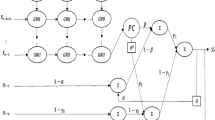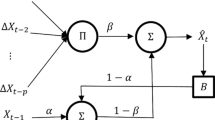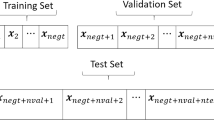Abstract
The simple recurrent artificial neural network is a deep artificial neural network frequently used in the literature for solving forecasting problems. It is preferred due to its low number of parameters. At the same time, the simple exponential smoothing method, which is one of the classical forecasting methods, is also used in the literature for solving forecasting problems. Both methods draw attention to their performance in solving forecasting problems. In this study, a hybrid approach is proposed in which these two methods, which perform very well in the forecasting problems of time series with seasonal components, are used together. The architecture of the network uses the forecasts during the seasonality period as recurrent. In the training of the proposed hybrid neural network, training algorithms based on particle swarm optimization algorithm and sine cosine optimization algorithms are proposed. The proposed training algorithms use a restart strategy to reduce the variability caused by random initial weights and to make the results more stable. In the recommended training algorithm, an early stopping condition is applied to solve the overfitting problem based on proportional error. The performance of this proposed method is analyzed using many seasonal time series and compared with both classical forecasting methods and deep and shallow artificial neural network methods.




Similar content being viewed by others
Data availability
Data will be made available on request.
References
Almosova A, Andresen N (2023) Nonlinear inflation forecasting with recurrent neural networks. J Forecast 42(2):240–259
Alshammari A (2023) Generation forecasting employing Deep Recurrent Neural Network with metaheruistic feature selection methodology for renewable energy power plants. Sustainable Energy Technol Assess 55:102968
Apaydin H, Feizi H, Sattari MT, Colak MS, Shamshirband S, Chau KW (2020) Comparative analysis of recurrent neural network architectures for reservoir inflow forecasting. Water 12(5):1500
Barkan O, Benchimol J, Caspi I, Cohen E, Hammer A, Koenigstein N (2023) Forecasting CPI inflation components with hierarchical recurrent neural networks. Int J Forecast 39(3):1145–1162
Bas E, Egrioglu E, Karahasan O (2021) A Pi-Sigma artificial neural network based on sine cosine optimization algorithm. Granul Comput 7:1–8
Bas E, Egrioglu E, Kolemen E (2022) Training simple recurrent deep artificial neural network for forecasting using particle swarm optimization. Granul Comput 7(2):411–420
Berradi Z, Omara LM, Mahboub O (2020) Effect of architecture in recurrent neural network applied on the prediction of stock price. IAENG Int J Comput Sci 47(3):436–441
Box GEP, Jenkins GM, Reinsel GC (1976) Time series analysis, forecasting and control, 3rd edn. Holden-Day, San Francisco, CA
Cansu T, Kolemen E, Karahasan Ö, Bas E, Egrioglu E (2023) A new training algorithm for long short-term memory artificial neural network based on particle swarm optimization. Granul Comput 8:1645–1658
Cao D, Chan M, Ng S (2023) Modeling and forecasting of nanoFeCu treated sewage quality using recurrent neural network (RNN). Computation 11(2):39
Chen SM (2002) Forecasting enrollments based on high-order fuzzy time series. Cybern Syst 33(1):1–16
Chen SM, Chen CD (2011) Handling forecasting problems based on high-order fuzzy logical relationships. Expert Syst Appl 38(4):3857–3864
Chen SM, Chen SW (2014) Fuzzy forecasting based on two-factors second-order fuzzy-trend logical relationship groups and the probabilities of trends of fuzzy logical relationships. IEEE Trans Cybern 45(3):391–403
Chen SM, Jian WS (2017) Fuzzy forecasting based on two-factors second-order fuzzy-trend logical relationship groups, similarity measures and PSO techniques. Inf Sci 391:65–79
Chen SM, Phuong BDH (2017) Fuzzy time series forecasting based on optimal partitions of intervals and optimal weighting vectors. Knowl-Based Syst 118:204–216
Chen SM, Zou XY, Gunawan GC (2019a) Fuzzy time series forecasting based on proportions of intervals and particle swarm optimization techniques. Inf Sci 500:127–139
Chen SM, Wang NY (2010) Fuzzy forecasting based on fuzzy-trend logical relationship groups. In IEEE transactions on systems, man, and cybernetics, part B (cybernetics), vol 40, no 5, pp 1343–1358.
Chen J, Xing H, Yang H, Xu L (2019) Network traffic prediction based on LSTM networks with genetic algorithm. In: Signal and information processing, networking and computers: proceedings of the 5th international conference on signal and information processing, Networking and Computers (ICSINC). Springer, Singapore, pp 411–419
Cho K, Van Merriënboer B, Bahdanau D, Bengio Y (2014) On the properties of neural machine translation: encoder-decoder approaches. arXiv:1409.1259
Edet S (2017) Recurrent neural networks in forecasting S&P 500 index. Available at SSRN 3001046
Egrioglu E, Baş E, Chen MY (2022) Recurrent dendritic neuron model artificial neural network for time series forecasting. Inf Sci 607:572–584
Egrioglu E, Bas E, Karahasan O (2023) Winsorized dendritic neuron model artificial neural network and a robust training algorithm with Tukey’s biweight loss function based on particle swarm optimization. Granul Comput 8(3):491–501
Fan MH, Chen MY, Liao EC (2021) A deep learning approach for financial market prediction: utilization of google trends and keywords. Granul Comput 6:207–216
Fandango A, Kapoor A (2018) Investigation of iterative and direct strategies with recurrent neural networks for short-term traffic flow forecasting. In Advances in computing and data sciences: second international conference, ICACDS, pp 433–441
Fandango A, Wiegand RP (2018) Towards investigation of iterative strategy for data mining of short-term traffic flow with recurrent neural networks. In Proceedings of the 2nd international conference on information system and data mining, pp 65–69
Hochreiter S, Schmidhuber J (1997) Long short-term memory. Neural Comput 9(8):1735–1780
Hyndman RJ, Athanasopoulos G (2018) Forecasting: principles and practice. OTexts, Melbourne
Jaihuni M, Basak JK, Khan F, Okyere FG, Sihalath T, Bhujel A, Kim HT (2022) A novel recurrent neural network approach in forecasting short term solar irradiance. ISA Trans 121:63–74
Jankauskas M, Serackis A, Pomornacki R, Šapurov M, Baškys A (2023) Short-term wind energy forecasting with advanced recurrent neural network models: a comparative study. In 2023 IEEE 10th jubilee workshop on advances in information, electronic and electrical engineering (AIEEE). IEEE, pp 1–5
Jovanovic L, Milutinovic N, Gajevic M, Krstovic J, Rashid TA, Petrovic A (2022) Sine Cosine Algorithm for Simple recurrent neural network Tuning for Stock Market Prediction. In 2022 30th telecommunications forum (TELFOR). IEEE, pp 1–4
Kumari P, Goswami VNH, Pundir RS (2023) Recurrent neural network architecture for forecasting banana prices in Gujarat. India PLoS One 18(6):e0275702
Liu Y, Qin Y, Guo J, Cai C, Wang Y, Jia L (2018) Short-term forecasting of rail transit passenger flow based on long short-term memory neural network. In 2018 international conference on intelligent rail transportation (ICIRT). IEEE, pp 1–5
Namdari H, Haghighi A, Ashrafi SM (2023) Short-term urban water demand forecasting; application of 1D convolutional neural network (1D CNN) in comparison with different deep learning schemes. Stoch Environ Res Risk Assess. https://doi.org/10.1007/s00477-023-02565-3
Nketiah EA, Chenlong L, Yingchuan J, Aram SA (2023) Recurrent neural network modeling of multivariate time series and its application in temperature forecasting. PLoS ONE 18(5):e0285713
Olmez E, Egrioglu E, Bas E (2023) Bootstrapped dendritic neuron model artificial neural network for forecasting. Granul Comput 8(6):1–11
Poongavanam E, Kasinathan P, Kanagasabai K (2023) Optimal energy forecasting using hybrid recurrent neural networks. Intell Autom Soft Comput 36(1):249–265
Rhouma A, Said Y (2023) Solar energy forecasting based on complex valued auto-encoder and recurrent neural network. Int J Adv Comput Sci Appl 14(4):390–395
Sarıkaya C, Bas E, Egrioglu E (2023) Training Sigma-Pi neural networks with the grey wolf optimization algorithm. Granul Comput 8:981–989
Shepelev V, Slobodin I, Almetova Z, Nevolin D, Shvecov A (2023) A hybrid traffic forecasting model for urban environments based on convolutional and recurrent neural networks. Transp Res Procedia 68:441–446
Shin Y, Ghosh J (1991) The pi-sigma network: An efficient higher-order neural network for pattern classification and function approximation. In IJCNN-91-Seattle international joint conference on neural networks, Seattle, WA, vol 1, pp 13–18
Smyl S, Dudek G, Pełka P (2023) ES-dRNN: a hybrid exponential smoothing and dilated recurrent neural network model for short-term load forecasting. IEEE transactions on neural networks and learning systems
Song H, Choi H (2023) Forecasting stock market indices using the recurrent neural network based hybrid models: CNN-LSTM, GRU-CNN, and ensemble models. Appl Sci 13(7):4644
Todo Y, Tamura H, Yamashita K, Tang Z (2014) Unsupervised learnable neuron model with nonlinear interaction on dendrites. Neural Netw 60:96–103
Vaheb H (2020) Asset price forecasting using recurrent neural networks. arXiv:2010.06417
Vanguri NY, Pazhanirajan S, Kuma TA (2023) Competitive feedback particle swarm optimization enabled deep recurrent neural network with technical indicators for forecasting stock trends. Int J Intell Robot Appl 7(2):385–405
Wang J, Wang J, Fang W (2016) Niu H (2016) Financial time series prediction using elman recurrent random neural networks. Comput Intell Neurosci 2016(12):1–14
Waseem KH, Mushtaq H, Abid F, Abu-Mahfouz AM, Shaikh A, Turan M, Rasheed J (2022) Forecasting of air quality using an optimized recurrent neural network. Processes 10(10):2117
Yadav RN, Kalra PK, John J (2007) Time series prediction with single multiplicative neuron model. Appl Soft Comput 7(4):1157–1163
Zeng S, Chen SM, Teng MO (2019) Fuzzy forecasting based on linear combinations of independent variables, subtractive clustering algorithm and artificial bee colony algorithm. Inf Sci 484:350–366
Zeroual A, Harrou F, Dairi A, Sun Y (2020) Deep learning methods for forecasting COVID-19 time-Series data: a comparative study. Chaos Solitons Fractals 140:110121
Author information
Authors and Affiliations
Contributions
OK: Methodology, Conceptualization, Writing, Data Analysis, Software. EE: Methodology, Conceptualization, Writing, Editing. EB: Methodology, Software, Writing, Conceptualization.
Corresponding author
Ethics declarations
Conflict of interest
The authors declare that they have no known competing financial interests or personal relationships that could have appeared to influence the work reported in this paper.
Additional information
Publisher’s Note
Springer Nature remains neutral with regard to jurisdictional claims in published maps and institutional affiliations.
Rights and permissions
Springer Nature or its licensor (e.g. a society or other partner) holds exclusive rights to this article under a publishing agreement with the author(s) or other rightsholder(s); author self-archiving of the accepted manuscript version of this article is solely governed by the terms of such publishing agreement and applicable law.
About this article
Cite this article
Karahasan, O., Bas, E. & Egrioglu, E. New deep recurrent hybrid artificial neural network for forecasting seasonal time series. Granul. Comput. 9, 19 (2024). https://doi.org/10.1007/s41066-023-00445-3
Received:
Accepted:
Published:
DOI: https://doi.org/10.1007/s41066-023-00445-3




